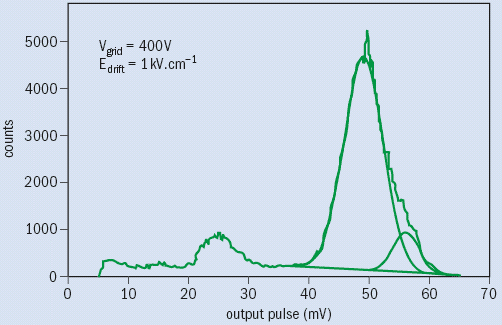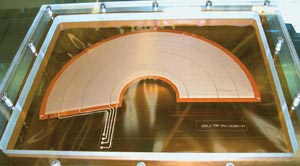A recent meeting at CERN reviewed the progress in the development of micro-pattern gas detectors for current and future particle-physics experiments.
Two hundred people gave a warm reception to Nobel laureate and detector pioneer Georges Charpak when he gave the opening talk at the Workshop on Micro-Pattern Gas Detectors at CERN on 20 January. The meeting began with a welcome from Jean-Jacques Blaising, head of CERN’s Physics Department, and continued with considerations of future challenges for particle detectors, overviews of the progress made on micro-pattern gas-detector technologies, and detailed presentations that emphasized production and running with these detectors. As the first in a series of workshops dedicated to reviewing the status of various particle-detector technologies, the formula adopted for this meeting was approved by the accumulated experts.

Aurore Savoy-Navarro of LPNHE-Université de Paris 6 addressed the basic questions surrounding the challenging future for particle detectors. With the Large Hadron Collider (LHC), particle physics will penetrate into the tera-electron-volt world, in explorations that will later be pursued together with another machine characterized by more stringent parameters. So what challenges do we expect? There will be increases in both the importance of the physics and the difficulty of the environment in the forward and very forward regions; increases in the number of jets and in the dynamic range required to observe them; an increase in the need for tagging particle flavours; increases in the flow of information, in the need for real-time decision-making, filtering and full processing of the data, together with an increasing demand for easy and worldwide access to the data; and there will, of course, be a need for increased robustness and reliability. So how do we cope with such a demanding future? Savoy-Navarro encouraged the exchange of information, Ramp;D and the pioneering of new technologies, also in collaboration with industry. However, the core question at the meeting was: “Can the micro-pattern gas detectors be an appropriate technology for future experiments?”

CERN’s Fabio Sauli described the recent developments and applications of the gas electron multiplier (GEM), a powerful detector concept that he introduced several years ago. In a GEM, a thin, metal-plated polymer foil is chemically pierced by a high density of microscopic holes. When a suitable voltage difference is applied between the two sides of the foil, each hole acts as an individual proportional counter, amplifying the ionization charge released in the gas. Several electrodes can be cascaded, leading to large gains and stable operating conditions in harsh radiation environments – a major point for the four speakers supporting GEM technology.

Sauli underlined two innovations in GEMs. With a caesium-iodide photosensitive layer deposited on the first electrode in a cascade, GEM devices provide efficient and fast detection of photoelectrons. With a resolution of a few nanoseconds and single-photon position accuracies better than a tenth of a millimetre, a GEM-based detector could form the basis of a new generation of ring-imaging Cherenkov particle identifiers. A large “hadron blind” detector exploiting these principles is being constructed for the upgrade of the PHENIX detector at the Brookhaven National Laboratory. Recent work at the Budker Institute for Nuclear Physics in Novosibirsk has demonstrated that GEM detectors can also work at cryogenic temperatures, which could lead to electronic bubble chambers.
Ioannis Giomataris of the Commissariat à l’Energie Atomique (CEA), Saclay, reviewed the micromesh gaseous structure chamber (Micromegas) detector. He recalled that the amplification process in a small gap has a fundamental feature: the gain reaches its maximum value for gaps in the range 30-150 μm. This key point in the Micromegas operation leads to extraordinary performance in several areas: stability, relative immunity to defects in flatness, and excellent energy resolution. The small amplification gap produces a narrow ionized avalanche, giving rise to excellent spatial and time resolution – several experiments measure 12 μm accuracy and time resolutions in the sub-nanosecond range. Giomataris pointed out that thanks to the fast collection of ions, the Micromegas can safely sustain particle fluxes larger than 105 mm-2s-1. He also introduced the Micromegas bulk, a new technology that is easy to implement, which has recently been developed in collaboration with the printed circuit board workshop at CERN. The detector, built in a single process, is light, low cost and robust.
In addition, Giomataris also presented applications of Micromegas in areas other than high-energy physics. These included a high-resolution detector for thermal neutron tomography; a detector with high time resolution for fast neutron detection in inertial confinement fusion experiments; and the novel compact, sealed Piccolo Micromegas detector, designed to provide in-core measurements of the neutron flux at a nuclear reactor and to give an estimation of the neutron energy.
The COMPASS fixed-target experiment at CERN has pioneered the use of multi-GEM and Micromegas detectors for tracking close to the beam line with particle rates of 25 kHz/mm2. Both technologies have shown excellent performance. Bernhard Ketzer of the Technischen Universität München and CERN gave a detailed description of the production and running experience accumulated with 22 large (31 cm2) GEM detectors with a triple amplification stage. All detectors operate with single-plane efficiencies greater than 97%, with a spatial resolution of 70 µm at a rate of 4 × 107/s. In addition, Fabienne Kunne of CEA-Saclay emphasized the excellent tracking capabilities of the largest Micromegas built to date, with an area of 40 cm2: they achieve a spatial resolution of 90 µm with full efficiency at a moderate gain.
Both speakers pointed out that no degradation of performance was observed in the COMPASS detectors after several years of operation with an accumulated charge of a few millicoulombs/cm2. With these results COMPASS has demonstrated the large-scale feasibility and reliability of the micro-pattern detector concept, and several years of flawless running have demonstrated its robustness and resistance to high radiation levels.
A Micromegas detector has also been developed for the CERN Axion Solar Telescope (CAST) experiment, which is searching for axions produced in the Sun’s core. George Fanourakis of the National Centre for Scientific Research “Demokritos”, Athens, explained that to find these rare events, the CAST Micromegas required demanding features – efficient detection of photons of 1-10 keV, stability, linearity and very good spatial and energy resolution with low background – all of which have been achieved. The detector has an X-Y strip structure on the same plane and reaches, after software filtering, an average background event rate of 5 × 10-5 keV-1 cm-2 s-1. In this way, the Micromegas detector at CAST has established the enormous potential of the technique in experiments to study rare events.
The NA48 experiment at CERN is using Micromegas detectors, and Kunne presented the spectrometer comprising three Micromegas stations coupled to a time projection chamber (TPC). Tracking of kaons, at rates exceeding several 107/s, is performed with a time resolution of 0.6 ns and a spatial resolution better than 100 μm. Kaons are tagged with a momentum resolution of 0.6%, which improves the resolution on missing masses significantly. A thin-gap (25 µm) Micromegas was also developed for the new proposal, P326, where the study of the rare decay K+ → pi;+νν requires tracking a flux of around 1.5 × 108/cm2/s.
Exploiting the technology
For the new LHC programme, two experiments, TOTEM and LHCb, have adopted GEM technology. Leszek Ropelewski of CERN described the TOTEM telescopes, made of triple-GEM detectors, which will be placed in the forward region of the CMS detector, where the charged-particle densities are estimated to be in the region of 106 cm-2s-1. Each of the telescopes will contain 20 half-moon detectors arranged in 10 planes, with an inner radius matching the beam pipe. TOTEM will exploit the full decoupling of the charge-amplification and charge-collection regions, which allows freedom in the optimization of the readout structure, a unique property of GEM detectors.
LHCb will use triple-GEM detectors with digital-pad readout to generate a fast and selective level-0 muon trigger in a small region close to the beam pipe. To trigger at 40 MHz a very fast gas mixture is needed. Alessandro Cardini from INFN Cagliari presented a detailed study performed on fast gas mixtures and showed that a triple-GEM detector fulfils the LHCb requirements in terms of efficiency in a 25 ns window, pad multiplicity, cross-talk and radiation hardness.
A key point that must be solved to promote micro-pattern detectors: industrialization of the production and manufacture of larger-size detectors.
Many groups worldwide develop the GEM and Micromegas technologies for future experiments at accelerators. An interesting use is in end-cap detectors for the TPCs of detectors for the International Linear Collider (ILC). The physics goals at the ILC require a detector with unprecedented tracking capabilities to be developed. Two major questions on the feasibility of a TPC based on a gas micro-pattern detector were addressed at the meeting, namely the problem of ion feedback and the two-track separation ultimately reachable. Stefan Roth of RWTH (Rheinisch-Westfälische Technische Hochschule) Aachen and Vincent Lepeltier of the Laboratoire de l’accelérateur linéaire, Orsay, responded by showing the excellent results obtained in a 4 T magnetic field with TPCs based on GEM and Micromegas detectors, namely a relative ion feedback of a few per-mille and position resolutions of less than 100 µm.
Harry Van der Graaf of NIKHEF presented two new detector concepts suitable for coupling to a TPC. The GridPix detector (95% efficient for single primary electrons) consists of a grid placed directly on top of the MediPix2 chip. A modification of MediPix2 is foreseen so as to record the arrival time of the drifted charges, allowing full 3D track reconstruction. With the InGrid technique, the grid is produced in wafer post-processing technology and integrated with a complementary-metal-oxide semiconductor pixel chip. This detector has shown an unprecedented energy resolution.
In the concluding discussion session, chaired by CERN’s Lucie Linssen, the community underlined a key point that must be solved to promote micro-pattern detectors: industrialization of the production and manufacture of larger-size detectors. There was applause for the team at CERN that optimized the production technique and that still devotes a great deal of effort to fulfilling the increasing demands for micro-pattern detectors.
The meeting unanimously agreed a concluding statement: the high radiation resistance and excellent time and spatial resolution, combined with a light structure, make these detectors attractive for high-precision tracking in future high-rate projects. It also became evident that pioneering and Ramp;D in detector technology are fundamental for cultivating synergy between the LHC and the ILC communities. There are many common issues to resolve and a mixture of the two cultures of e+e– and pp colliders, along with an adventurous mind, is what we need to confront future detector challenges successfully.
Further reading
For the workshop programme and presentations see http://indico.cern.ch/event/473.





